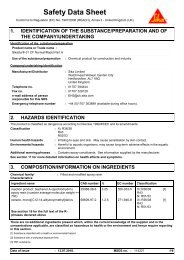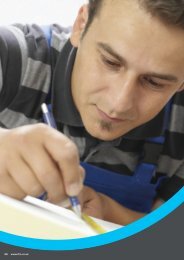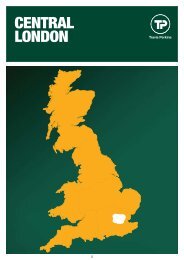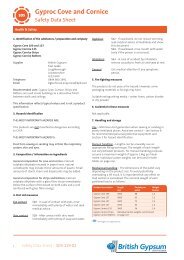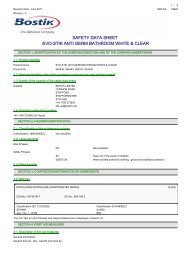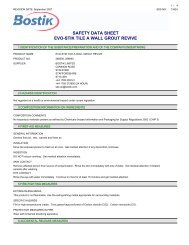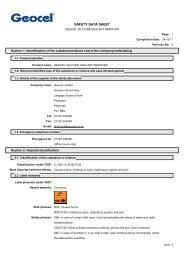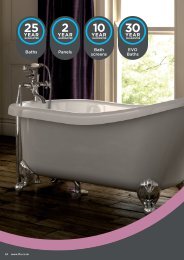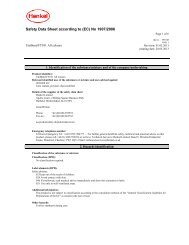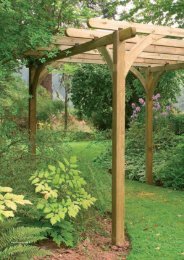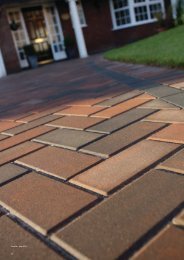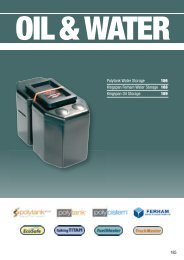SHEET MATERIALS - Travis Perkins
SHEET MATERIALS - Travis Perkins
SHEET MATERIALS - Travis Perkins
You also want an ePaper? Increase the reach of your titles
YUMPU automatically turns print PDFs into web optimized ePapers that Google loves.
jargon buster<br />
BB face<br />
Some minor defects are allowed, but panel<br />
should be repaired and sanded to give a<br />
smooth finish. <strong>Travis</strong> <strong>Perkins</strong> Q Mark plywood<br />
although specified as a BB face is in reality<br />
closer to a B face.<br />
BS1088<br />
British Standard still used to determine the<br />
specification of Marine Plywood.<br />
BS5268<br />
A design standard used by architects<br />
to determine what products to use<br />
in construction. It is not a method of<br />
manufacture. Plywood details include strength<br />
tables testing products in situ.<br />
CC face<br />
Allows various defects (eg splits) but generally<br />
accepted in the UK that most defects will be<br />
filled and board will be sanded.<br />
CCX<br />
Upgrade of CDX using a C grade on face and<br />
on the back of the panel.<br />
CDX<br />
Originally the grade of softwood plywood from<br />
North America with a type 1 glue line. Now<br />
adopted by other manufacturers who still<br />
produce C faces and a D face on the reverse,<br />
the glue line is now usually in accordance<br />
with EN314. C allows for shallow open knots<br />
on the face.<br />
CE 2+<br />
This is stating that the manufacturer has<br />
adhered to all the necessary tests required<br />
within the CPR. The 2+ indicates that a third<br />
party has initially tested the manufacturer’s<br />
product performance and has then monitored<br />
the factory’s controls to ensure continuity of<br />
product performance.<br />
CE4<br />
This is a non structural performance test that<br />
doesn’t need third party monitoring.<br />
Class 0<br />
Term used to describe Fire Retardent panels<br />
in accordance with BS476 part 6 :- For areas<br />
where limited combustibility is required,<br />
usually in high risk places such as escape<br />
routes. This will be superseded in new<br />
European standards by Euro class B.<br />
Class 1<br />
Term used to describe Fire Retardant panels<br />
in accordance with BS476 part 6 :- Surface<br />
spread of flame. This will be superseded in<br />
new European standards by Euro class C.<br />
Combi<br />
A term used when the plywood is a mixture of<br />
hardwood and softwood.<br />
CPR<br />
Construction Products Regulation, effective in<br />
all European countries. Dictates requirements<br />
for products to be used in construction.<br />
EN 13986<br />
Wood-based panels for use in construction -<br />
characteristics, evaluation of conformity and<br />
marking. A harmonised European standard<br />
that implements the CPR for wood panel<br />
products. Lists all appropriate EN standards<br />
needed for manufacturers to comply with CPR.<br />
EN300<br />
European standard describing requirements<br />
for manufacture of chipboard. Standard refers<br />
to seven different grades: P1 is standard<br />
chipboard, P2 and P3 refer to furniture grades,<br />
P4 is a flooring grade, P5 is a moisture<br />
resistant flooring grade, P6 is heavy duty and<br />
P7 is moisture resistant heavy duty.<br />
EN 314<br />
Test for bond quality (glue) for plywood. Three<br />
classifications : EN314 / 1 /2 / 3. EN314/1<br />
Dry conditions. EN314/2 Humid conditions.<br />
EN314/3 Exterior conditions.<br />
EN 636<br />
Details requirements for different uses. There<br />
are three service classes: EN 636/1 Dry<br />
EN636/2 Humid, EN636/3 Fully exterior. The<br />
vast majority of plywood will not comply with<br />
EN636/3 unless it is treated or coated.<br />
Eurocode 5<br />
Will supersede BS 5268. Supplies architects<br />
and specifiers the means to provide<br />
compliance with CPR.<br />
Hardwood Faced<br />
Usually indicates that although the face and<br />
back is hardwood, the core could be softwood.<br />
PTS<br />
Term used to upgrade the face of softwood ply<br />
Plugged and Touch Sanded.<br />
Q Mark<br />
Set up by TRADA. The Q Mark is a strict<br />
third party evaluation to ensure that the<br />
manufacturing mill carry out all the necessary<br />
procedures to ensure the plywood is structural<br />
in accordance with EN 13986. This is<br />
monitored on a continuous basis.<br />
TG2 /TG4<br />
An abbreviation used to indicate that the board<br />
is tongued and grooved. Either on 2 long edges<br />
or all 4 edges.<br />
Throughout<br />
Description qualifying that all the veneers<br />
within the plywood are all hardwood or all<br />
softwood.<br />
WBP<br />
Weather and Boil Proof. WBP is an endearing<br />
term that is used by a large majority to<br />
describe exterior plywood. Officially WBP was<br />
a term used in BS6566 Part 8 determining<br />
the grade of glue. This standard (BS 6566)<br />
actually became obsolete in 1998 and is now<br />
superseded by EN 314.<br />
56<br />
www.travisperkins.co.uk<br />
www.travisperkins.co.uk<br />
57




